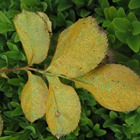Last column, I wrote about fertilising your roses – essential for growing good roses. A well fed rose will reward you will many beautiful blooms and will make growing them much easier. Well-fed roses also won't attract so many pests and diseases meaning they will look better.
 This column, I will talk about some of the common diseases that affect roses and some of the ways you can minimise their appearance in your garden. I know for many years' roses have been perceived as being 'disease prone' and that many people are put off growing them because of this.
This column, I will talk about some of the common diseases that affect roses and some of the ways you can minimise their appearance in your garden. I know for many years' roses have been perceived as being 'disease prone' and that many people are put off growing them because of this.
In recent years, great progress has been made in producing new varieties that have great tolerance to the common diseases. That is not to say they won't get them, but will look good for longer and still perform if affected.
The other thing to remember is that diseases, like everything else living, are constantly evolving. There are varieties that were never affected years ago by certain diseases, are now badly affected today. The variety hasn't changed (some people think it has), it's the disease which has evolved.
When you spray, you never get a 100% strike rate so there is always something that will survive. Of course, the best way to manage this is to use different sprays if you use them to manage resistance building up.
Blackspot
Blackspot is a well-known disease characterised by black spots on the leaves. It appears on the upper surface of leaves. Eventually leaves will turn yellow and fall off. Mild temperatures and wet leaf surfaces encourage black spot infection so where possible, avoid overhead irrigation. High humidity and lack of ventilation doesn't help either so make sure there is some air movement around your plants. Blackspot will also over winter in fallen foliage, hence the need to pick up all fallen leaves during winter.
 Rust
Rust
Rust is also well known and is characterised by small orange spots on the bottom surface of the leaves. Later on they can be visible on the top side of the leaves as orange or brown spots. Rust develops in cool, wet weather. There are varieties than can be quite susceptible to rust infection so these are best avoided. Also picking up fallen leaves helps but spores can also be blown in on the wind.
Powdery Mildew
Powdery mildew can also put in an appearance. It is characterised by white powdery growth on the surface of leaves, stems and in some cases, the blooms. Younger leaves can become distorted with infection. A heavy infection can weaken the plant. Powdery develops when there are moderate temperatures and high humidity so good ventilation is essential in preventing it in the first place.
Downy Mildew
Downy Mildew (not be confused with the above) is sometimes incorrectly identified as black spot. The main difference is that blackspot has distinctive 'spots' while downy has purplish red to dark irregular spots. Infected leaves can turn yellow and fall from the plant. Sometimes it can also affect stems.
Downy mildew develops in fluctuating temperatures and high humidity so again, good air movement and picking up fallen leaves minimises its impact.
They are the four main diseases that you may encounter with your roses. If you do need to spray to control things, consult with your local rose society or garden centre/hardware store for recommendations.
Coming up: I've been busy including rose show dates on the New Zealand Rose Society website www.nzroses.org.nz and don't forget the big rose event of 2013, the International Rose show being held in Palmerston North 23rd and 24th November. Further details are on the website as well.










Join the Discussion
Type out your comment here:
You must be logged in to post a comment.